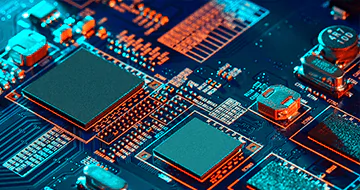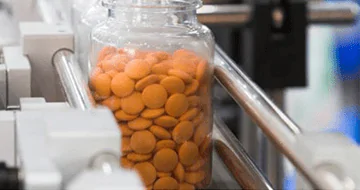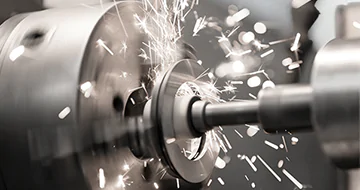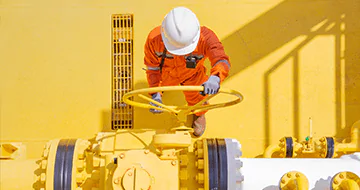Veri Matrisi (DataMatrix) Kod Nedir?
Veri matrisi kodu, (ECC200) kare ve dikdörtgen olmak üzere iki biçime sahiptir ve her zaman çift sayıda modül içerir.
Veri Matrisi (DataMatrix) Kod Yapısı
Veri matrisi kodu, 1987 yılında ID Matrix tarafından geliştirilen bir matris 2D kodudur. 1996 yılında AIMI’nin ISS standardına ve 2000 yılında ISO/IEC standardına kaydedilmiştir
| Özellikler | |||
|---|---|---|---|
| En küçük boyut | 10 x 10 modül | ||
| En büyük boyut | 144 x 144 modül | ||
| Maksimum veri kapasitesi | Sayısal | 3116 karakter | |
| Alfa sayısal | 2335 karakter | ||
ECC000, ECC050, ECC080, ECC100 ve ECC140, Veri matrisi (DataMatrix) kodunun eski sürümleri arasında bulunur.
ECC200, Veri matrisi (DataMatrix) kodunun en son versiyonudur ve konfigürasyonda (yapılandırmada) kare veya dikdörtgen olabilir.
ECC000, ECC050, ECC080, ECC100, ECC140
Konvolüsyon (evrişim) düzeltmesi kullanarak 9 x 9’dan 49 x 49’a tek sayılı modüllerden oluşurlar.
Veri boyutu büyük olduğunda hafif bir bozulma okumayı bozacağından, eski sürümler neredeyse hiç kullanılmaz.
ECC200
ECC200, bozulma sorunlarını önleyebilmek için hata düzeltme kapasitesini yükseltmiştir.
Kodun bir parçası zarar gördüğünde verileri onaran hata düzeltmesi için Reed-Solomon kullanılır.
ECC200 uluslararası olarak standartlaştırılmıştır. Genellikle ECC200 versiyonu Veri matrisi (DataMatrix) kodu gerektiğinde kullanılır.


Veri Matrisi (DataMatrix) Kodlarının Yapısı (ECC200)
Hizalama ve saat modeli
Veri matrisi (DataMatrix) kodlarının veri alanı, hizalama modeli olarak adlandırılan L şeklinde bir çerçeve ve saat modeli olarak adlandırılan noktalı çizgilerle çevrilidir. Okuyucular, görüntü işleme ile kodun konumunu belirlemek için bu kalıpları yakalar. Böylece Veri matrisi (DataMatrix) kodları herhangi bir yönden okunabilir.
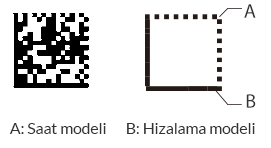
24 X 24’ten fazla modül olduğunda, kod her bir tarafta 24 modülü aşmayacak şekilde bloklara bölünür. Bu yapı, kodun bozulmasını engeller.
Kod boyutu ve blok numaraları
10 x 10 modülden 144 x 144 modüle kadar (dikdörtgen tip için altı boyut dahil) yirmi dört kod boyutu vardır. Bir kod 26 x 26’dan fazla modüle sahip olduğunda (veri için 24 x 24’ten fazla modül), aşağıda görüldüğü gibi her bir tarafta 24 modülü aşmayan bloklara bölünür. Bu yapı, kodun bozulmasını engeller.
| Sembol boyutu | Blok/parça | Veri hücresi |
|---|---|---|
| 10×10 to 26×26 | 1 | 8×8 to 24×24 |
| 28×28 to 52×52 | 4 | 14×14 to 24×24 |
| 64×64 to 104×104 | 16 | 14×14 to 24×24 |
| 120×120 to 144×144 | 36 | 18×18 to 22×22 |

Kenar boşluğu
2D kodlar, kodun hasar görmesi veya lekelenmesi durumunda verileri onarmaya olanak tanıyan yerleşik hata düzeltme özelliğine sahiptir.
Veri yapılandırması için matematiksel hata düzeltmesi (Reed-Solomon) kullanılır.
Veri matrisi (DataMatrix) kodunun etrafındaki kenar boşluğu bir modülden daha büyük olmalıdır.
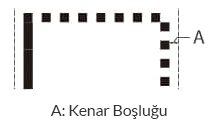
Hata düzeltme kodu (Reed-Solomon code)
Reed-Solomon kodu, Veri matrisi (DataMatrix) kodunun bir parçası hasar gördüğünde verileri onarır.
Verilerin düzenlenmesi ve hata düzeltme kodu
Veriler ve hata düzeltme kodları aşağıdaki gibi düzenlenir.
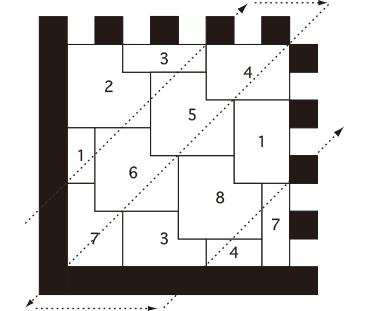
“YSK”yı Veri matrisi (DataMatrix) koduna dönüştürebilmek için YSK kodlanmalı, hata düzeltme kodu aşağıda gösterildiği gibi hesaplanmalı ve kare içerisinde düzenlenmelidir.

Veri matrisi (DataMatrix) Kodunun Özellikleri
Veri matrisi (DataMatrix) kodu (ECC200), kare ve dikdörtgen olmak üzere iki yapılandırmaya sahiptir ve her zaman çift sayıda hücre içerir.
Kare tip

| Kare tip Veri matrisinin (DataMatrix) teknik özellikleri (ECC200) | |||
|---|---|---|---|
| Minimum boyut | 10 x 10 modül | ||
| Maksimum boyut | 144 x 144 modül | ||
| Maksimum veri kapasitesi | Sayısal | 3116 karakter | |
| Alfa sayısal | 2335 karakter | ||
| Çift (İkili) | 1556 karakter | ||
10 x 10 modülden 144 x 144 modüle kadar değişen yirmi dört sembol boyutu vardır. 24 x 24’ten fazla modül olduğunda, kod her bir tarafta 24 modülü aşmayan bloklara bölünür. Bu yapı, kodun bozulmasını engeller.
Dikdörtgen tip

| Dikdörtgen tip Veri matrisinin (DataMatrix) teknik özellikleri (ECC200) | |||
|---|---|---|---|
| Minimum boyut | 8 x 16 modül | ||
| Maksimum boyut | 16 x 48 modül | ||
| Maksimum veri kapasitesi | Sayısal | 98 karakter | |
| Alfa sayısal | 72 karakter | ||
| Çift (İkili) | 47 karakter | ||
Dikdörtgen bir tipte aşağıda gösterilen altı boyut vardır.
• 8 x 18 modül (1 blok)
• 12 x 26 modül (1 blok)
• 16 x 36 modül (1 blok)
• 8 x 32 modül (2 blok)
• 12 x 36 modül (2 blok)
• 16 x 48 modül (2 blok)

Veri matrisi (DataMatrix) kod boyutunu belirleme
Veri matrisi (DataMatrix) kodunun gerçek boyutu, sembolün boyutu ile modülün yazdırılabilir boyutu çarpılarak belirlenir.
Modül boyutu 0,25 mm olduğunda,
Sembol boyutu: 10 x 10 modül = 2,5 x 2,5 mm
Sembol boyutu: 32 x 32 modül = 8,0 x 8,0 mm
Sembol boyutu: 8 x 18 modül = 2,0 x 4,5 m
Her bir sembol boyutunun veri kapasitesi
Kare tip
| Modül numaraları | Veri kapasitesi | Hata düzeltme oranı | ||
|---|---|---|---|---|
| Sayısal | Alfa sayısal | Çift (İkili) | ||
| 10 x 10 | 6 | 3 | 1 | %25 |
| 12 x 12 | 10 | 6 | 3 | %25 |
| 14 x 14 | 16 | 10 | 6 | %28’den %39’a |
| 16 x 16 | 24 | 16 | 10 | %25’ten %38’e |
| 18 x 18 | 36 | 25 | 16 | %22’den %34’e |
| 20 x 20 | 44 | 31 | 20 | %23’ten %38’e |
| 22 x 22 | 60 | 43 | 28 | %20’den %34’e |
| 24 x 24 | 72 | 52 | 34 | %20’den %35’e |
| 26 x 26 | 88 | 64 | 42 | %19’dan %35’e |
| 32 x 32 | 124 | 91 | 60 | %18’den %34’e |
| 36 x 36 | 172 | 127 | 84 | %16’dan %30’a |
| 40 x 40 | 228 | 169 | 112 | %15’ten %28’e |
| 44 x 44 | 288 | 214 | 142 | %14’ten %27’ye |
| 48 x 48 | 348 | 259 | 172 | %14’ten %27’ye |
| 52 x 52 | 408 | 304 | 202 | %15’ten %27’ye |
| 64 x 64 | 560 | 418 | 278 | %14’ten %27’ye |
| 72 x 72 | 736 | 550 | 366 | %14’ten %26’ya |
| 88 x 88 | 1152 | 862 | 574 | %14’ten %27’ye |
| 96 x 96 | 1392 | 1042 | 694 | %14’ten %27’ye |
| 104 x 104 | 1632 | 1222 | 814 | %15’ten %28’e |
| 120 x 120 | 2100 | 1573 | 1048 | %14’ten %27’ye |
| 132 x 132 | 2608 | 1954 | 1302 | %14’ten %26’ya |
| 144 x 144 | 3116 | 2335 | 1556 | %14’ten %27’ye |
Dikdörtgen tip
| Modül numaraları | Veri kapasitesi | Hata düzeltme oranı | ||
|---|---|---|---|---|
| Sayısal | Alfa sayısal | Çift (İkili) | ||
| 8 x 18 | 10 | 6 | 3 | %25 |
| 8 x 32 | 20 | 13 | 8 | %24 |
| 12 x 26 | 32 | 22 | 14 | %23’ten %37’ye |
| 12 x 36 | 44 | 31 | 14 | %23’ten %38’e |
| 16 x 36 | 64 | 46 | 30 | %21’den %38’e |
| 16 x 48 | 98 | 72 | 47 | %18’den %33’e |

Yukarıda bulunan tablodaki her karakter sayısı, girilebilecek maksimum karakter sayısını gösterir.
Bununla birlikte, veriler yukarıdaki tabloda belirtilenden daha az karakter içerse bile, veri bileşenine bağlı olarak bir sembol boyutu büyür (örneğin, rakamlar ve sembollerin kombinasyonu veya büyük ve küçük harflerin kombinasyonu).
GS1 Veri matrisi (DataMatrix)
GS1 Veri matrisi (DataMatrix), dağıtım için GS1 tarafından standart hale getirilmiş bir 2D kod sembolüdür. ECC200 Standardını baz alır ve geleneksel Veri matrisi (DataMatrix) kodundan kendini ayırmak için aşağıdaki kuralları tanımlar.
GS1 Veri matrisi (DataMatrix) kodunun temel içeriği
| Kullanılan kod | Veri matrisi (DataMatrix) ECC200 |
| FNC1 | [FNC1] GS1’in standart özellikleri olarak tanımlamak için verinin başına yerleştirilir. |
| Uygulama tanımlayıcısı (AI) | Tanımlayıcı kodu ne tür bilgilerin takip ettiğini tanımlamak için veri şeridinin başına eklenen tanımlayıcı bir kod. Uygulama tanımlayıcıları (AI) ISO/IEC tarafından belirlenmiştir. |
| Değişken uzunluk verileri |
Miktar gibi toplam bilginin değiştiği (değişken uzunluk verileri) verileri girerken, değişken uzunluklu verilerden sonra ayırıcı olarak [FNC1] girin. Bu [FNC1], bir kod okuyucu tarafından okunduğunda [GS] (ASCII kodunda 1Dh) çıktısı vermek üzere belirlenir. * [GS – Group separator]: Grup ayırıcı [GA] |
GS1 modülü için baskı boyutu
GS1 Veri matrisi (DataMatrix), dağıtım için GS1 tarafından standartlaştırılmış bir 2D kod sembolüdür. ECC200 Standardını baz alır ve geleneksel Veri matrisi (DataMatrix) kodundan kendini ayırmak için aşağıdaki kuralları tanımlar.
| Önerilen modül boyutu | Maksimum modül boyutu | Minimum modül boyutu | |
|---|---|---|---|
| Etiket üzerine yazdırma | 0.300mm | 0.615mm | 0.255mm |
| DPM | 0.380mm | 0.495mm | 0.380mm |
GS1 Veri matrisi (DataMatrix) kodu örneği
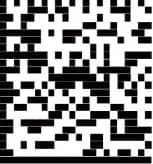
| Öğe | AI | Veri |
|---|---|---|
| GTIN (14 sabit basamak) | 01 | 04912345678904 |
| Miktar (değişken uzunluk) | 30 | 100 |
| Satış tarihi | 17 | 120401 |
GS1-128 ile İlişkisi
GS1 Veri matrisi (DataMatrix) kodu, GS1-128 ile aynı veri yapısına sahiptir. Bu nedenle, baskı alanı sınırlı olmasına rağmen büyük miktarda veri ile uğraşmak gerektiğinde kullanılması olasıdır. Ayrıca, GS1 Veri matrisi (DataMatrix) kodu tıp endüstrisinde standart hale getirilecektir. Kodlar, cerrahi bıçak ve makas gibi çelik tıbbi aletlere doğrudan basılacağından, yönergeler oluşturulmuştur.
Çelik tıbbi alet: Paslanmaz, alüminyum, bakır alaşımı, titanyum veya seramik gibi malzemelerden üretilen ve tıbbi prosedürlerde ve ameliyatlarda tekrar kullanılan bir alettir.

